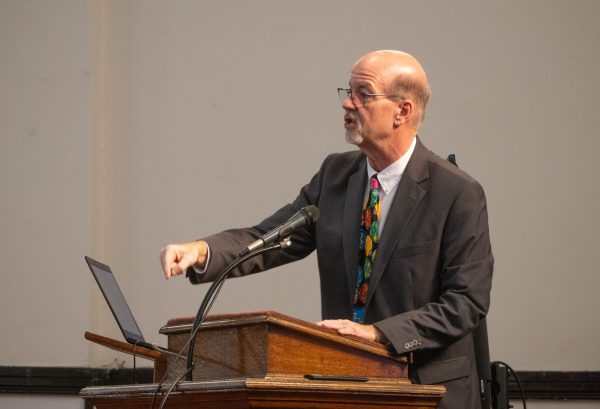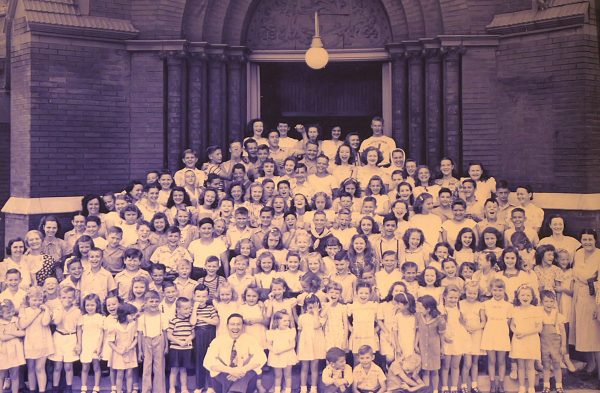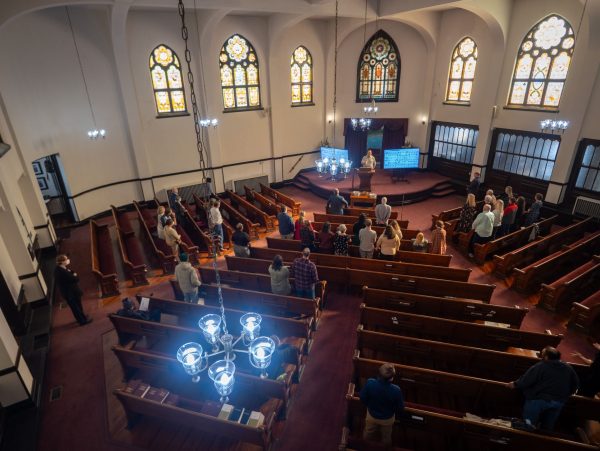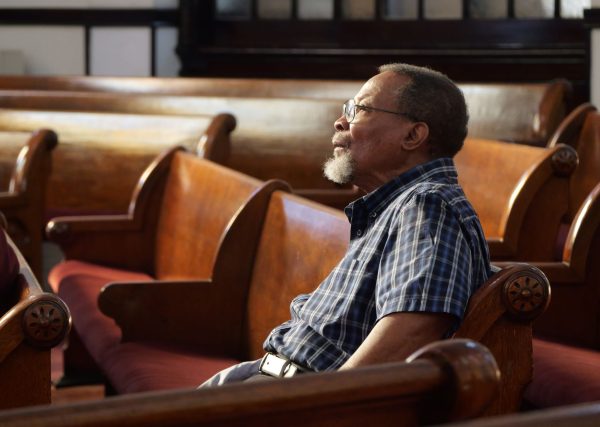
‘There’s so much to carry forward’
SILVER POINT, Tenn. — At first glance, it looked like…
| Refresh | This website christianchronicle.org/preserving-to-serve/ is currently offline. Cloudflare's Always Online™ shows a snapshot of this web page from the Internet Archive's Wayback Machine. To check for the live version, click Refresh. |
|
Getting your Trinity Audio player ready...
|
NASHVILLE, Tenn. — The Sunday sun streams through the Lindsley Avenue Church of Christ’s stained glass windows, rimming the dark wooden benches with a golden halo.
But it’s the people — some from the suburbs, others from the streets — who really light up the place.

Filtering through the 10 stained glass windows in Lindsley Avenue’s auditorium, the sunlight dapples in gold the building’s 19th-century pews.
Likely the oldest Church of Christ still meeting in downtown Nashville, Lindsley Avenue has roots reaching to the 1850s. The ornate windows, turrets, gables, pinnacles and cupola of its building — which dates from 1894 — survived sweeping urban changes to maintain the congregation’s compassionate presence in the city’s heart.
Lindsley Avenue’s identity features twin hallmarks: the striking architecture and the willingness to serve everyone who finds the way in.
Related: ‘There’s so much to carry forward’
“You walk in there, and you see the stained glass, and you see the grand space, and you see folks from every walk of life sitting together in that auditorium. It’s absolutely inspiring,” said member Brett Smith, a landscape architect. “All walks of life, all are welcome under a very inspiring, beautiful vestige of architecture.”
Robbie Newlin, a member since 1987 and now the church administrator, echoed that sentiment.
“Everybody that comes in — no matter what socioeconomic background you have (or) race or whatever — everybody is the same as they walk through that door,” she said.
After a recent assembly, Lindsley Avenue regular Patrick Gardner affectionately thanked Newlin as she handed him a sack lunch.
A Nashville native, Gardner has attended services there for about a year.
“I love it,” he said. “I love the atmosphere, the people. I feel like they’re very sincere. I feel the Spirit of God. People really feel like they’re being acknowledged.”
“I love the atmosphere, the people. I feel like they’re very sincere. I feel the Spirit of God. People really feel like they’re being acknowledged.”
Gardner grew up Seventh-day Adventist but had stopped attending.
“I just happened to come here one day,” he said of Lindsley Avenue.
“Somebody invited me — another homeless person. I felt like this is where I was supposed to be.”

Not an angle or flourish on Lindsley Avenue’s red-brick facade goes to waste in the 1894 building’s striking asymmetrical design.
Minister Gene Wright sees the congregation’s urban location as a factor in its welcoming nature.
The Nashville Rescue Mission sits less than a mile from the building. Interstate 40 passes within a stone’s throw, slicing in two what was once the church’s backyard.
“We’re not in a suburb,” Wright said. “We don’t have to go out and beat the highways and byways. … The people come to us.”

Lindsley Avenue minister Gene Wright addresses the congregation behind a pulpit inherited from the South College Street congregation formed in Nashville in the second half of the 19th century.
To be at Lindsley Avenue is to meet needs. “It’s not for the faint of heart,” Newlin said. She recalled with member Gina Tek a dramatic Sunday five years ago.
During the middle of worship, a member with a history of seizures suddenly fell to the floor and began seizing. A couple of nurses in attendance stabilized him. Then emergency help arrived.
“We just had a prayer, and everybody went home,” Newlin remembered.
Related: One of America’s oldest Churches of Christ celebrates its 200th anniversary
Newlin and Tek said the church developed a plan for similar incidents in the future. Tek escorts the children out. Newlin calls an ambulance. Wright asks the congregation to remain seated.
“Everybody has a little job to do,” Newlin explained.
“God’s hand, it shows continually at Lindsley,” the administrator said, quoting a former minister’s reference to Lindsley Avenue as “the little church on the corner that could.”
The building the “little church” owns is an architectural treasure — and an expensive one to maintain.
How do you choose between maintenance and mission?
At Lindsley Avenue, you don’t.

Restoration of Lindsley Avenue’s elegant windows involves more than the glass itself, the windows’ wooden frames betraying a century’s exposure to weather and downtown grime.
“We prayed a lot,” Newlin said. The answer was PLAN — Preserve Lindsley Avenue Now — a nonprofit that the congregation established in 2015 specifically to preserve the building.
“PLAN exists to ensure that this special building will be here for future generations,” explains PLAN’s website, which is separate from the congregation site but linked to it.

Last fall, the nonprofit to preserve Lindsley Avenue’s building won a $30,750 grant from the Tennessee Historical Commission to restore a stained glass window.
“We’re preserving to be able to serve,” Newlin said.
Independent status allows PLAN to seek funding from donations and grants. Last fall, the nonprofit won a $30,750 grant from the Tennessee Historical Commission to restore a stained glass window. The church estimates the repair — for just one window — will cost at least $50,000.
The windows are the last phase in a preservation plan that called first for structural repairs, now completed, to shore up the building.
Understanding the congregation now meeting in that historic structure requires looking back before the Civil War.
The congregation traces its beginnings to antebellum Nashville, when David Lipscomb, founder of what would become Lipscomb University, preached the Gospel to three women and a child gathered southeast of downtown.

A 19th-century membership ledger from South College Street Christian Church — predecessor to Lindsley Avenue Church of Christ — lists David Lipscomb and his wife Margaret. David Lipscomb served as elder for the South College Street congregation.
After the Civil War, Nashville grew, and so did the number of believers, who met at various places around town. Some of those believers bought property less than a mile from where Lindsley Avenue meets today and eventually built on the lot.
On Nov. 13, 1887, the South College Street Christian Church — with “Christian Church” a frequent 19th-century designation for Restoration Movement congregations — conducted its inaugural service. Famed evangelist T.B. Larimore preached.
Related: The oldest Church of Christ in America? It’s complicated
Lindsley Avenue’s current building enters the story around 1920, part of a tale of two churches.
By that time, South College Street had outgrown its facilities. But nearby Grace Presbyterian Church — its elegant building dating from the 1890s — had declined amid controversy. So the two neighboring congregations swapped buildings.

Students and teachers at a mid-1940s Lindsley Avenue Vacation Bible School crowd the church building entrance. Seated in the bottom row, a smiling Ira North reflects the day’s excitement.
South College Street absorbed the Carroll Street Christian Church, and the new combined congregation, taking the name of Lindsley Avenue Church of Christ, paid the Presbyterians $5,000 to seal the deal. On Oct. 17, 1920, the first worship service of the Lindsley Avenue congregation drew an estimated 1,600 people.
The two churches simply traded a baptistry for an organ, Newlin said, adding that $5,000 was a considerable sum at the time.
In hindsight, Lindsley Avenue got a bargain.

Bright yellows bathe Lindsley Avenue’s worship space as the congregation stands to sing. The unique building served as the setting of the 2006 feature film “The Second Chance.”
The building’s red bricks and mortar enclose a semicircular worship space flooded by the light of 10 out of the structure’s 45 stained glass windows.
Every exterior surface is unique in shape or architectural flourish, creating a symphony of asymmetry. The structure’s “decorative exuberance is unmatched in existing Nashville churches,” according to a Metro Historical Commission document. The building entered the National Register of Historic Places in May 1984.
“When people come in, they’re like, ‘Never seen a Church of Christ look like this.’”
“When people come in, they’re like, ‘Never seen a Church of Christ look like this,’” Newlin said.
The design reflects the “Akron Plan,” developed in Ohio, that featured Sunday school rooms connected to an auditorium via moveable glass partitions.
The dividers — Lindsley Avenue has six — would stay down during class but could be raised for overflow crowds during worship.

A detail from stained glass windows in the room where the congregation serves Sunday breakfast promotes “Christian Endeavor,” a youth program in which Grace Presbyterian Church participated prior to Lindsley Avenue’s acquisition of its building.
Lindsley Avenue inherited the original communion table and pulpit from the South College Street church and uses them every Sunday.
Several of the many historic photos Lindsley Avenue has on display depict a young Ira North — later the beloved preacher for the Madison Church of Christ near Nashville — surrounded by excited kids at a Lindsley Avenue Vacation Bible School. North preached for the congregation for several years beginning in the mid-1940s.
Related: In a Mexican resort city, Christians care for homeless ‘angels’
In the ensuing decades, Lindsley Avenue would face a declining membership and a dramatically changed urban setting. During the 1980s, the congregation witnessed an uptick in the number of unhoused people attending.
At one point during the 1990s, “we had a member die a week,” Newlin said. “My husband came home from a men’s meeting, and he said, ‘I think we’re going to have to close the doors,’” Newlin recalled. “I just looked at him, and I said, ‘I don’t think so.’”
With post-pandemic attendance now around 45 people — about a fourth of them unhoused persons — and a core of about 25 shouldering the work, Lindsley Avenue is determined to use its unique location and worship space to show the love of Christ.
“I’ve never seen such a small group of people do so much,” Smith said. “When there’s a lot of people, there’s always somebody else to do it. … When it’s a smaller group and there’s a lot of goals and a lot of need, it’s all hands on deck.”

Lindsley Avenue church administrator Robbie Newlin assists two members in the congregation’s clothing room, beneficiary of a recent grant from Vine Street Christian Church in Nashville, at one time attended — like Lindsley Avenue’s congregational predecessor — by David Lipscomb.
The congregation serves a monthly potluck. Every Sunday starts with coffee and doughnuts. Members prepare weekly food bags. A clothing room offers winter coats.
While the church declines requests for cash, it gladly provides bus passes. Every Sunday afternoon, members hold a worship service with communion for around 15 residents of an assisted living facility across town.
Wright thinks about his spiritual heritage as minister for Lindsley Avenue and the influence of the space where he preaches.
“I always feel like I’m surrounded by a great cloud of witnesses, of the individuals who have served … before, to much larger crowds, but who have been serving in that neighborhood for a long time.”
“I always feel like I’m surrounded by a great cloud of witnesses, of the individuals who have served … before, to much larger crowds, but who have been serving in that neighborhood for a long time,” Wright said.
“You can use the beauty of the building to … teach from,” he observed. “Hopefully the beauty of the sunlight coming through the stained glass … reminds people the creator of the sun is there in the middle with us.”

Lindsley Avenue member Howard Webb listens intently on a Sunday.
Smith is grateful the congregation has remained in its historic setting.
“There is still a mission of being Christians,” he said, “and giving that cup of water and giving out the clothes when someone’s cold.”
The Lindsley Avenue member praised his predecessors for “keeping that total package of iconic architecture, of spirituality, of a downtown presence … of staying there and running the course.”
To help Lindsley Avenue preserve its historic building, see givingmatters.civicore.com/preservelindsleyavenuenow.
Subscribe today to receive more inspiring articles like this one delivered straight to your inbox twice a month.
Your donation helps us not only keep our quality of journalism high, but helps us continue to reach more people in the Churches of Christ community.